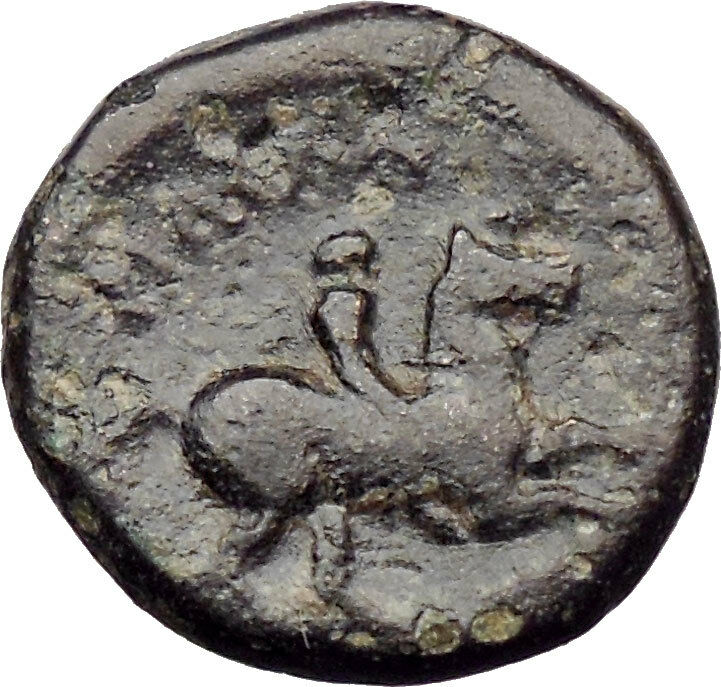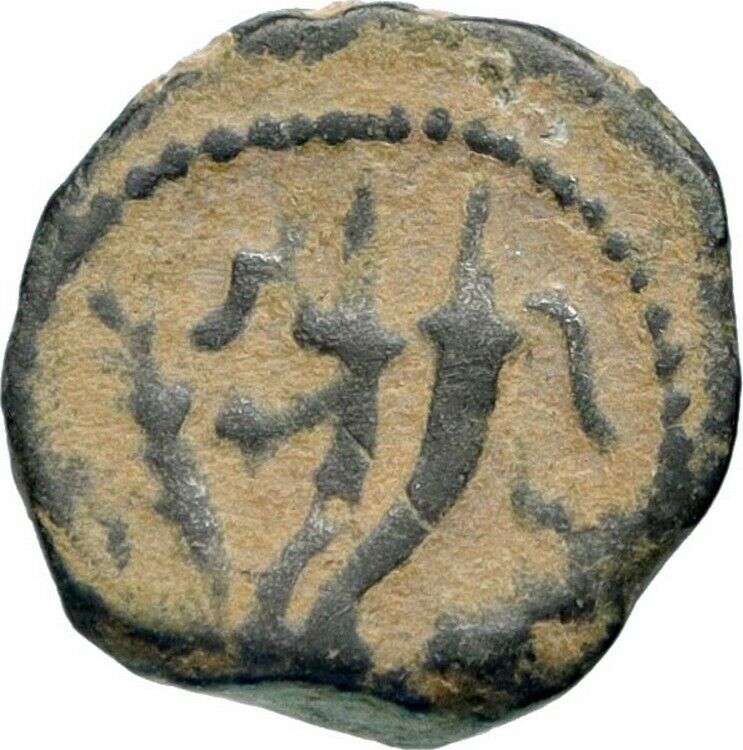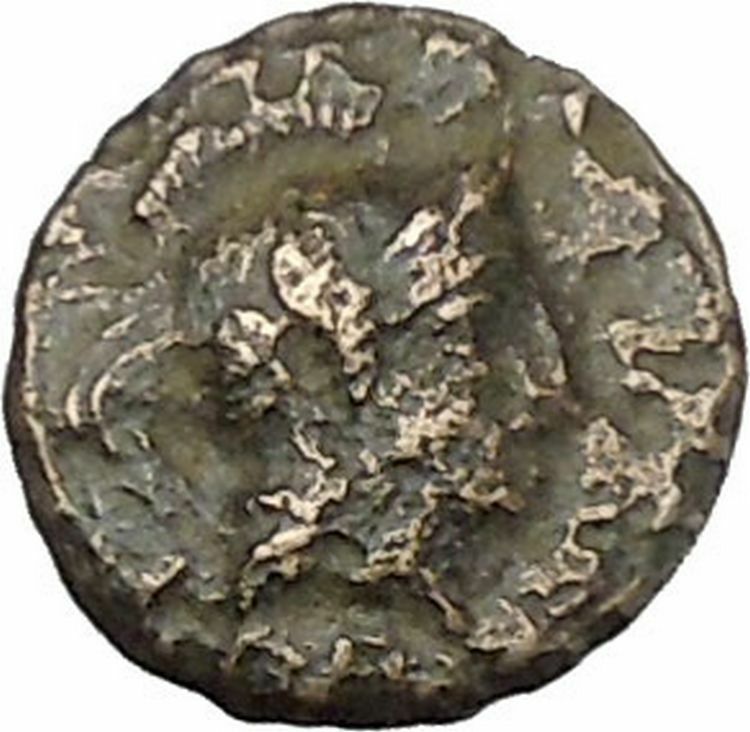|
Greek city of Epeirote Republic in Epirus
Bronze 18mm (4.41 grams) Struck circa 234-168 B.C.
Reference: Sear 2001; SNG Copenhagen 132-134
Head of Dione right, veiled and wearing laureate stephanos; ANT monogram behind.
AΠEI / PΩTAN either side of tripod-lebes; all within laurel-wreath.
You are bidding on the exact item pictured, provided with a Certificate of Authenticity and Lifetime Guarantee of Authenticity.
 A sacrificial tripod is a three-legged piece of religious furniture used for offerings or other ritual procedures. As a seat or stand, the tripod is the most stable furniture construction for uneven ground, hence its use is universal and ancient. It is particularly associated with Apollo and the Delphic oracle in ancient Greece, and the word “tripod” comes from the Greek meaning “three-footed”. A sacrificial tripod is a three-legged piece of religious furniture used for offerings or other ritual procedures. As a seat or stand, the tripod is the most stable furniture construction for uneven ground, hence its use is universal and ancient. It is particularly associated with Apollo and the Delphic oracle in ancient Greece, and the word “tripod” comes from the Greek meaning “three-footed”.
The most famous tripod of ancient Greece was the Delphic Tripod from which the Pythian priestess took her seat to deliver the oracles of the deity. The seat was formed by a circular slab on the top of the tripod, on which a branch of laurel was deposited when it was unoccupied by the priestess. In this sense, by classical times the tripod was sacred to Apollo. According to the myth, Hercules went to the oracle of Delphi in order to ask what to do in order to be expiated from the murder of Iphitos. The oracle did not want to give him an omen. Then, the hero was enraged and he grabbed the tripod on which the Pythia sat in order to pronounce her oracles. Apollo tried to prevent him and this resulted in a fight between the god and the hero. Finally, Zeus had to intervene in order to end this quarrel.The mytheme of Heracles contesting with Apollo for the tripod appears in vase-paintings older than the oldest written literature. The oracle originally may have been related to the primal deity, the Earth. In the Geometric period, the tripods were fastened to the cauldrons they supported. In the Museum of Delphi there are fragments of such tripods, most distinctive of which is the one with a ring-shaped handle.
Another well-known tripod in Delphi was the Plataean Tripod; it was made from a tenth part of the spoils taken from the Persian army after the Battle of Plataea. This consisted of a golden basin, supported by a bronze serpent with three heads (or three serpents intertwined), with a list of the states that had taken part in the war inscribed on the coils of the serpent. The golden bowl was carried off by the Phocians during the Third Sacred War (356-346 BC); the stand was removed by the emperor Constantine to Constantinople in 324, where in modern Istanbul it still can be seen in the hippodrome, the Atmeydanı, although in damaged condition: the heads of the serpents have disappeared, however one is now on display at the nearby Istanbul Archaeology Museums. The inscription, however, has been restored almost entirely. Such tripods usually had three ears (rings which served as handles) and frequently had a central upright as support in addition to the three legs.
Tripods frequently are mentioned by Homer as prizes in athletic games and as complimentary gifts; in later times, highly decorated and bearing inscriptions, they served the same purpose. They appear also to be precious gifts for the guests, as in the case of the Phaeakes, who offered a cauldron and tripod to Odysseus. Our guest has already packed up the clothes, wrought gold, and other valuables which you have brought for his acceptance; let us now, therefore, present him further, each one of us, with a large tripod and a cauldron. We will recoup ourselves by the levy of a general rate; for private individuals cannot be expected to bear the burden of such a handsome present. Odyssey, 13.10-15 [tr. S. Butler] They also were used as dedicatory offerings to the deities, and in the dramatic contests at the Dionysia the victorious choregus (a wealthy citizen who bore the expense of equipping and training the chorus) received a crown and a tripod. He would either dedicate the tripod to some deity or set it upon the top of a marble structure erected in the form of a small circular temple in a street in Athens, called the street of tripods, from the large number of memorials of this kind. One of these, the Choragic Monument of Lysicrates, erected by him to commemorate his victory in a dramatic contest in 335 BC, still stands. The form of the victory tripod, now missing from the top of the Lysicrates monument, has been rendered variously by scholars since the 18th century.
Martin L. West writes that the Pythia at Delphi shows many traits of shamanistic practices, likely inherited or influenced from Central Asian practices. He cites her sitting in a cauldron on a tripod, while making her prophecies, her being in an ecstatic trance state, similar to shamans, and her utterings, unintelligible.
According to Herodotus (The Histories, I.144), the victory tripods were not to be taken from the temple sanctuary precinct, but left there as dedications.
The Epirote League was an ancient Greek coalition (koinon) of Epirote tribes.
History
The coalition was established between 370 and 320 BC, (firstly as the Molossian League in 370 BC), which helped unify the three main tribes of Epirus (i.e. Molossians, Thesprotians, and Chaonians). The political, economic, and cultural center of the Epirote League was Dodona. Dodone was the religious, political and cultural centre of the Molossian League and later of the Epirote League. Pyrrhus of Epirus became leader of the League in 297 BC. When King Agathocles of Syracuse conquered Corcyra, he offered the island as dowry to his daughter Lanassa on her marriage to Pyrrhus of Epirus in 295 BC. The island then became a member of the Epirote League. It was then perhaps that the settlement of Cassiope was founded to serve as a base for the king of Epirus’ expeditions. The island remained in the Epirote League until 255 BC when it became independent after the death of Alexander II of Epirus. The league was defeated by the Illyrians during the Invasion of Epirus and the Battle of Phoenice, forcing them to enter into an alliance with Teuta to prevent further attacks. This alliance made the Epirotes hostile to the Acheaens and Aetolians, but presumably ended following Illyrian defeat in the First Illyrian War.
Although the League remained neutral in the first two Macedonian Wars, it was ultimately dismantled in the Third Macedonian War (171–168 BC), with the Molossians siding with the Macedonians and the Chaonians and Thesprotians supporting the Roman Republic.
Decrees of the League
Copies of the decrees (proxeny and citizenship decrees, manumission records) of the Molossian and Epirote League were set up in Dodona. All members had common citizenship. Regarding the dialect of the Epirote League, it was not Corinthian Doric and even the alphabet was not Corinthian; it was probably Northwest Doric, as some recorded inquiries at Dodona appear to indicate. The first epigraphical evidence of the Molossian League goes back to 370 BC under the king (or basileus) Neoptolemus.
See also
 |
Wikimedia Commons has media related to Epirote League coins. |
- Epirus (ancient state)
- Chaonians
- Thesprotians
- Molossians
Epirus was an ancient Greek state, located in the geographical region of Epirus in the western Balkans. The homeland of the ancient Epirotes was bordered by the Aetolian League to the south, Thessaly and Macedonia to the east, and Illyrian tribes to the north. For a brief period (280–275 BC), the Epirote leader Pyrrhus managed to make Epirus the most powerful state in the Greek world, and his armies marched against Rome during an unsuccessful campaign in Italy.
History
Prehistory
Epirus has been occupied since at least Neolithic times by seafarers along the coast and by hunters and shepherds in the interior who brought with them the Greek language. These people buried their leaders in large tumuli containing shaft graves, similar to the Mycenaean tombs, indicating an ancestral link between Epirus and the Mycenaean civilization. A number of Mycenaean remains have been found in Epirus, especially at the most important ancient religious sites in the region, the Necromanteion (Oracle of the Dead) on the Acheron river, and the Oracle of Zeus at Dodona.
The Dorians invaded Greece from Epirus and Macedonia at the end of the 2nd millennium BC (circa 1100–1000 BC), though the reasons for their migration are obscure. The region’s original inhabitants were driven southward into the Greek mainland by the invasion and by the early 1st millennium BC three principal clusters of Greek-speaking tribes emerged in Epirus. These were the Chaonians of northwestern Epirus, the Molossians in the center, and the Thesprotians in the south.
Molossian expansion (470–330 BC)
The Molossian Aeacidae dynasty managed to create the first centralized state in Epirus from about 370 BC onwards, expanding their power at the expense of rival tribes. The Aeacids allied themselves with the increasingly powerful kingdom of Macedon, in part against the common threat of Illyrian raids, and in 359 BC the Molossian princess Olympias, niece of Arybbas of Epirus, married King Philip II of Macedon (r. 359–336 BC). She was to become the mother of Alexander the Great. On the death of Arybbas, Alexander the Molossian, uncle of Alexander the Great of Macedon, succeeded to the throne with the title King of Epirus.
In 334 BC, the time Alexander the Great crossed into Asia, Alexander I the Molossian led an expedition in southern Italy in support of the Greek cities of Magna Graecia against the nearby Italian tribes and the emerging Roman Republic. After some successes on the battlefield, he was defeated by Rome and killed in battle circa 331 BC.[7]
Kingdom of Epirus (330–231 BC)
Campaigns of Pyrrhus of Epirus in Italy.
In 330 BC, upon Alexander the Molossian’s death, the term “Epirus” appears as a single political unit in the ancient Greek records for the first time, under the leadership of the Molossian dynasty. Subsequently, the coinages of the three major Epirote tribal groups came to an end, and a new coinage was issued with the legend Epirotes. After Alexander’s I death, Aeacides of Epirus, who succeeded him, espoused the cause of Olympias against Cassander, but was dethroned in 313 BC.
Aeacides’s son Pyrrhus came to the throne in 295 BC. Pyrrhus, being a skillful general, was encouraged to aid the Greeks of Tarentum and decided to initiate a major offensive in the Italian peninsula and Sicily. Due to its superior martial abilities, the Epirote army defeated the Romans in the Battle of Heraclea (280 BC). Subsequently, Pyrrhus’s forces nearly reached the outskirts of Rome, but had to retreat to avoid an unequal conflict with a more numerous Roman army. The following year, Pyrrhus invaded Apulia (279 BC) and the two armies met in the Battle of Asculum where the Epirotes won the original Pyrrhic victory, at a high cost.
In 277 BC, Pyrrhus captured the Carthaginian fortress in Eryx, Sicily. This prompted the rest of the Carthaginian-controlled cities to defect to Pyrrhus. Meanwhile, he had begun to display despotic behavior towards the Sicilian Greeks and soon Sicilian opinion became inflamed against him. Though he defeated the Carthaginians in battle, he was forced to abandon Sicily.
Pyrrhus’s Italian campaign came to an end following the inconclusive Battle of Beneventum (275 BC). Having lost the vast majority of his army, he decided to return to Epirus, which finally resulted in the loss of all his Italian holdings. Because of his costly victories, the term “Pyrrhic victory” is often used for a victory with devastating cost to the victor.
Epirote League (231–167 BC)
Further information: Epirote League
Coin of the Epirote League, depicting Zeus (left) and a lighting bolt with the word “ΑΠΕΙΡΩΤΑΝ” , “of the Epirotes” (right).
In 233 BC, the last surviving member of the Aeacid royal house, Deidamia, was murdered. Her death brought the Epirote royal family to an abrupt extinction and a federal republic was set up, though with diminished territory, since western Acarnania had asserted its independence, and the Aetolians seized Ambracia, Amphilochia, and the remaining land north of the Ambracian Gulf. The new Epirote capital was therefore established at Phoenice, the political center of the Chaonians. The reasons for the swift fall of the Aeacid dynasty were probably complex. Aetolian pressure must have played a part, and the alliance with Macedonia may have been unpopular; in addition, there were perhaps social tensions. However, Epirus remained a substantial power, unified under the auspices of the Epirote League as a federal state with its own parliament (or synedrion).
In the following years, Epirus faced the growing threat of the expansionist Roman Republic, which fought a series of wars with Macedonia. The League remained neutral in the first two Macedonian Wars but split in the Third Macedonian War (171–168 BC), with the Molossians siding with the Macedonians and the Chaonians and Thesprotians siding with Rome. The outcome was disastrous for Epirus; Molossia fell to Rome in 167 BC and 150,000 of its inhabitants were enslaved.
Organization
Political structure of the ancient Greek world (8th–5th centuries BC).
In antiquity, Epirus was settled by the same nomadic Hellenic tribes that went on to settle the rest of Greece. Unlike most other Greeks of the time, who lived in or around city-states such as Athens or Sparta, the Epirotes lived in small villages and their way of life was foreign to that of polis of southern Greeks. Their region lay on the edge of the Greek world and was far from peaceful; for many centuries, it remained a frontier area contested with the Illyrian peoples of the Adriatic coast and interior. However, Epirus had a far greater religious significance than might have been expected given its geographical remoteness, due to the presence of the shrine and oracle at Dodona – regarded as second only to the more famous oracle at Delphi.
Culture
The Epirotes were speakers of an epichoric Northwest Greek dialect, different from the Dorian of the Greek colonies on the Ionian islands, and bearers of mostly Greek names, as evidenced by epigraphy. They seem to have been regarded with some disdain by some classical Greek writers. The 5th century BC Athenian historian Thucydides describes them as “barbarians” in his History of the Peloponnesian War, as does Strabo in his Geography. Other writers, such as Dionysius of Halicarnassus, Pausanias, and Eutropius, describe them as Greeks. Simon Hornblower interprets the vague, and sometimes even antithetical, comments of Thucydides on the Epirotes as implying that they were neither completely “barbarian” nor completely Greek, but akin to the latter. Nicholas Hammond opines that the principal social structure of the Epirotes was the tribe and that they spoke a West-Greek dialect.
Plutarch mentions an interesting cultural element of the Epirotes regarding the Greek hero Achilles. In his biography of King Pyrrhus, he claims that Achilles “had a divine status in Epirus and in the local dialect he was called Aspetos” (meaning unspeakable, unspeakably great, in Homeric Greek).
See also
- List of cities in ancient Epirus
|





 A sacrificial tripod is a three-legged piece of religious furniture used for offerings or other ritual procedures. As a seat or stand, the tripod is the most stable furniture construction for uneven ground, hence its use is universal and ancient. It is particularly associated with Apollo and the Delphic oracle in ancient Greece, and the word “tripod” comes from the Greek meaning “three-footed”.
A sacrificial tripod is a three-legged piece of religious furniture used for offerings or other ritual procedures. As a seat or stand, the tripod is the most stable furniture construction for uneven ground, hence its use is universal and ancient. It is particularly associated with Apollo and the Delphic oracle in ancient Greece, and the word “tripod” comes from the Greek meaning “three-footed”.







